Devising a High-Yield Bond Fund Exit Strategy
December 13 2015 - 7:50PM
Dow Jones News
After long piling into funds that bought some of the
lowest-rated debt, investors are asking themselves a basic question
now: When they decide to get out, will they be able to?
That fundamental attribute of mutual funds got new scrutiny this
week, as Third Avenue Focused Credit Fund took the unusual step of
blocking redemptions and telling investors it could take a year or
more for them to be paid all of what they are due. The fund said it
put up the gates to facilitate an orderly liquidation amid severe
declines in bond prices and heavy withdrawal requests.
Third Avenue may be unique given its outsize weighting in
particularly risky and hard-to-sell securities, said Jeff
Tjornehoj, head of Americas research at Thomson Reuters Lipper.
Still, he and others said other funds also could be at risk of a
liquidity squeeze—and pointed to measures that investors can look
at to gauge a fund's chances of having to scramble to pay departing
investors.
Those factors include a fund's exposure to assets that may prove
particularly hard to unload, its cash cushion, the degree of
concentration in top holdings and the magnitude of recent
outflows.
In looking at junk-bond funds, one thing to consider is how a
fund allocates its assets among bonds of different credit ratings
and/or debt that isn't rated. The Third Avenue fund had 89% of its
assets in debt that was rated lower than B or not rated, according
to Morningstar data.
"Nonrated, it can be harder to trade under stress," said Russel
Kinnel, director of manager research at Morningstar Inc.
Some senior executives in the industry say problems at the Third
Avenue fund are representative of risks taken by managers of one
portfolio, rather than signs of a systemic problem in mutual funds.
They argue that mutual fund managers have a long track record of
handling heavy redemptions and winding down funds where
necessary.
Current Securities and Exchange Commission guidelines say mutual
funds should hold a maximum of 15% of their total holdings in
illiquid assets. The regulator in September proposed a new rule
that would overhaul how funds manage liquidity risk, or the
potential that their investors won't be able to cash out promptly
at the prices they have been led to believe their fund holdings are
worth.
Another risk indicator: how much of a mutual fund's assets are
concentrated in its top 10 holdings, Mr. Kinnel said. The typical
fund will have a diffuse portfolio. Vanguard High-Yield Corporate
Fund, for example, had 9.1% of its assets in its top 10 holdings,
and its top holding accounted for about 1.4% of the portfolio as of
Sept. 30, according to Morningstar. Third Avenue Focused Credit
Fund, in contrast, had 28.4% of its assets in its top 10 holdings,
and its top holding accounted for nearly 4.8% of the fund as of the
end of July, according to Morningstar.
High-yield funds attracted net inflows for nine months in a row
to May 2014, as investors searched for returns amid a prolonged
period of low interest rates. But flows have been more volatile
since. Investors pulled money from high-yield funds in six months
of the 11 months this year, according to Morningstar, including a
$3.3 billion outflow last month.
Concerns are heightened now because investors often move to sell
money-losing fund positions and investments late in the year to
generate losses that can offset their taxable income. The average
junk bond fund is down 3% so far this year, after counting dividend
income, according to Morningstar, but some are down more, making
those holdings a logical choice for some investors to sell.
Concerns about liquidity in parts of the bond market could make
exits more likely.
"When a fund offers liquidity on a daily basis but holds
illiquid assets, it creates a first-mover advantage," said Itay
Goldstein, a finance professor at the University of Pennsylvania's
Wharton School.
An investor who redeems shares of the fund will receive net
asset value as of that day's market close. But that price doesn't
reflect what the fund can collect for the assets it has to
sell.
"Those costs of liquidation will be imposed on the other
investors who stay in the fund," he said. "If you're the first one
to leave, you're in better shape than those who wait."
Among the 10 high-yield funds that have seen the biggest
outflows in dollars this year, a spokeswoman for Aberdeen Asset
Management PLC said the company's global high-income fund is well
diversified and invests in more-liquid segments of the high-yield
market. A Fidelity Investments spokeswoman said the firm is
confident in the positioning and liquidity of its high-yield funds
and continues to view the asset class as an attractive one for
long-term investors.
A Franklin Resources Inc. spokeswoman said the firm hasn't had
any issues managing redemptions and maintains a line of credit that
its high-yield funds have never used. "We have experience managing
through all market cycles, and we look ahead to prepare for periods
of higher outflows by holding a cushion of liquid investments," she
said.
Avenue Capital Group, Metropolitan West Asset Management LLC,
Waddell & Reed Financial Inc., Pacific Investment Management
Co. and American Funds either declined to comment or didn't respond
to requests for comment.
Write to Daisy Maxey at daisy.maxey@wsj.com, Sarah Krouse at
sarah.krouse@wsj.com and Jason Zweig at
intelligentinvestor@wsj.com
(END) Dow Jones Newswires
December 13, 2015 19:35 ET (00:35 GMT)
Copyright (c) 2015 Dow Jones & Company, Inc.
Waddell and Reed Financial (NYSE:WDR)
Historical Stock Chart
From Jun 2024 to Jul 2024

Waddell and Reed Financial (NYSE:WDR)
Historical Stock Chart
From Jul 2023 to Jul 2024
